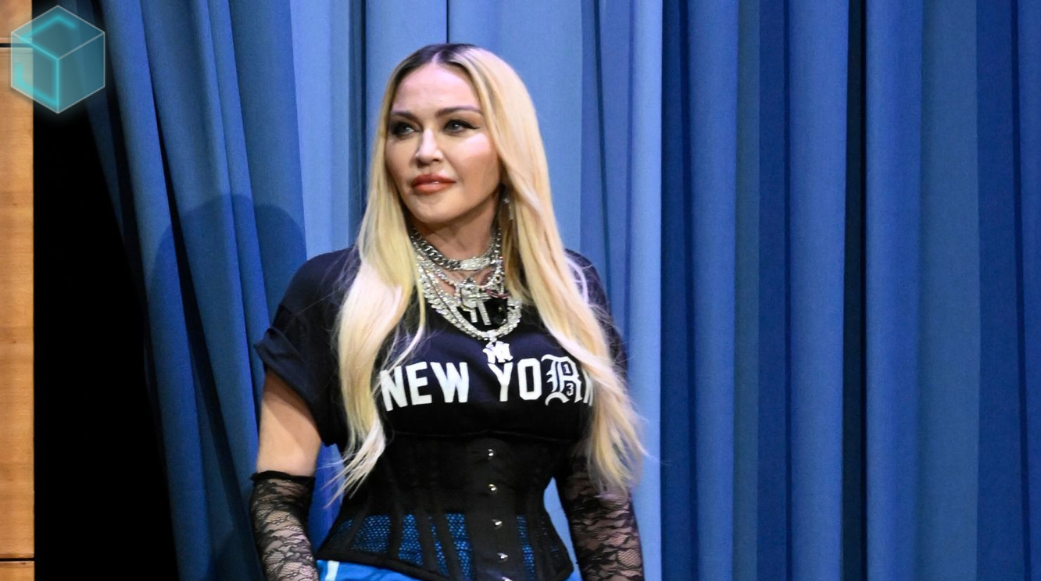
August 21, 2025
Cardi B is officially back in album mode. On Friday, the rap superstar released her new single “Imaginary Playerz,” a bold track that samples Jay-Z’s classic “Imaginary Player.” The release comes...
Read more
August 21, 2025
Gary Oldman opened up about his decades-long friendship with the late David Bowie, calling the world a very different place since the music icon’s death in January 2016. In a heartfelt interview...
Read more
August 21, 2025
The Queen of Pop just proved she's still the ultimate trendsetter even when it comes to birthday cakes. Madonna rang in her 67th birthday with a luxurious Italian getaway capped off by an enormous...
Read more
August 20, 2025
Former Little Mix star Jade Thirlwall isn't mincing words about artists who avoid political engagement, specifically calling out The 1975's Matty Healy for what she sees as a privileged stance. In...
Read more
August 20, 2025
PinkPantheress has once again cracked the code of Gen Z’s collective brain chemistry with her track Illegal. It’s short, it’s addictive, and it’s the kind of song that makes you feel like you’re...
Read more
August 20, 2025
Conan Gray has never been shy about writing songs that feel like reading your high school diary at 2 a.m. with the lights off. But with Caramel, he’s gone full Willy Wonka heartbreak mode. It’s...
Read more
August 20, 2025
PinkPantheress has always had a gift for making music that feels like it was recorded inside your daydreams, half diary entry, half late-night Tumblr scroll. With Romeo, she’s taken that talent and...
Read more
August 20, 2025
Every so often, a song arrives that feels less like a single and more like a cinematic event. LISA’s latest release, DREAM featuring Japanese actor and heartthrob Kentaro Sakaguchi, is exactly that...
Read more
August 20, 2025
If Cardi B has taught us anything, it’s that she doesn’t just rap, she throws down verbal haymakers wrapped in couture and glitter. Her new joint, “Imaginary Playerz,” is a full-on drag session for...
Read more
August 20, 2025
Everyone’s favorite pop-punkers, Joyce Manor, are back with their first new song in three years. The surprise single, “All My Friends Are So Depressed,” is out now via Epitaph Records, blending...
Read more
August 20, 2025
In 2025, Christian culture is prevalent, although it was previously on the outside of popular music. The Billboard Hot 100 is dominated by religious-themed songs like Benson Boone's...
Read more
August 20, 2025
Michael Tait, a well-known Christian rock musician (DC Talk, Newsboys), has admitted to engaging in "unwanted sensual" behavior and substance misuse for decades. Multiple accusers allege abuse...
Read more.png)
Teaching music to young children is a rewarding but challenging experience, especially if you're used to playing instruments yourself rather than instructing others. Whether it’s drums, piano, guitar, or any other instrument, working with younger students requires a different approach than teaching older or more advanced learners. Children learn best through play, exploration, and interaction, and your teaching methods need to reflect that.
If you’re feeling unsure about how to approach teaching kids, don’t worry—you’re not alone. Many experienced musicians have struggled to transition into teaching roles, especially with younger students. However, with the right mindset and strategies, you can provide engaging and effective music lessons for children.
Here are some tips, including examples of famous music educators and musicians who’ve succeeded in teaching kids.
1. Start with the Basics in a Fun and Engaging Way
Young children can easily get overwhelmed by complex music theory or technical skills. When teaching kids, keep things simple and fun. Start with the basics—teaching them how to hold the instrument, the names of notes, or basic rhythm patterns. Use games, songs, and activities that will keep them interested and engaged.
What You Can Do:
For Piano: Teach basic scales and chords through interactive games, like matching colored notes to keys.
For Drums: Use rhythm games that involve clapping or playing along with a simple beat. You can use soft drumsticks or hand drums to introduce the concept.
For Guitar: Start with one or two simple chords, and practice them in the context of a fun song they recognize.
Example: Mister Rogers from Mister Rogers' Neighborhood integrated music into his TV show for young children. His simple approach, using repetition and songs that children already loved, made music both educational and enjoyable for kids. By keeping things playful and light, he kept their attention and fostered a love for music at a young age.
2. Incorporate Visual and Hands-On Learning
Children are visual and tactile learners. Use physical objects, flashcards, or colorful visuals to help them understand musical concepts. Incorporating movement and hands-on activities will also make the lessons more memorable and enjoyable.
What You Can Do:
Use Visuals: For example, when teaching piano, use stickers on the keys to represent different notes. For guitar, use color-coded tabs or strings to help them learn the basic finger positions.
Interactive Rhythm Exercises: For drums, you can create fun rhythm challenges using everyday objects like buckets, shakers, or bells, letting the child experiment with sound and rhythm.
Flashcards and Charts: Use flashcards with notes or rhythms for the child to match with what they hear or see on their instrument.
Example: Suzuki Method, developed by Dr. Shinichi Suzuki, emphasizes the importance of a hands-on, visual, and auditory approach to teaching music to children. He used listening and imitation before introducing reading music, which allowed children to experience music physically and emotionally before engaging with complex theory.
3. Break Lessons Into Shorter Segments
Young children have short attention spans, so it’s important to break the lesson into short, varied segments. Switching between activities every 5-10 minutes keeps them from becoming bored or frustrated. For example, you could spend a few minutes learning a chord, switch to a fun rhythm game, and then have a quick listening session to keep them engaged.
What You Can Do:
Rotate Activities: Spend 10 minutes on scales, followed by 10 minutes on rhythm exercises, and finish with 10 minutes playing a simple song.
Incorporate Breaks: Give them mini-breaks to stand up, move around, or have a quick chat to prevent them from getting restless.
Use Rewards or Praise: Positive reinforcement helps keep kids motivated. Celebrate small achievements like learning a new note or mastering a basic beat.
Example: Leonard Bernstein, the famous conductor and educator, was known for breaking down complex musical ideas into short, digestible segments in his Young People’s Concerts. He made classical music approachable for children by focusing on one concept at a time and engaging them with fun and interactive explanations.
4. Use Songs They Know and Love
Children love familiarity, so teaching songs they already know can make lessons more enjoyable. If a child recognizes the song they’re learning, they’ll be more likely to engage with it. This builds confidence and keeps them motivated.
What You Can Do:
For Guitar: Teach simple versions of songs like "Twinkle, Twinkle, Little Star" or popular kids' songs with basic chords.
For Piano: Start with easy nursery rhymes or songs from children’s movies like Frozen or The Lion King.
For Drums: Teach them how to drum along to their favorite pop songs, focusing on simple rhythms.
Example: Paul McCartney started learning music through familiar songs and simple tunes. His father was a musician and would encourage him to play along with popular songs of the day, making music relatable and enjoyable from the start. Using songs that children love is a tried-and-true method for building early engagement with music.
5. Encourage Creativity and Exploration
One of the best ways to keep younger children engaged is to allow them room for creativity. Encourage them to make up their own songs, experiment with different sounds, or even invent their own rhythms. This taps into their natural curiosity and makes the lessons feel more like play than work.
What You Can Do:
Create Simple Compositions: Let them create their own mini-compositions by combining notes or rhythms they’ve learned.
Improvise Together: Play an instrument while they experiment with theirs, allowing them to feel free to explore sounds.
Allow Exploration Time: Give them time during the lesson to “play” with the instrument without structure. This encourages them to learn through trial and error.
Example: Yo-Yo Ma, the legendary cellist, often emphasizes the importance of creativity in music education. He encourages young musicians to experiment with sound and explore different ways of playing to keep their passion alive. Allowing children to express their creativity can make lessons feel less restrictive and more enjoyable.
6. Patience and Understanding Are Key
Teaching younger children can be unpredictable. Some days, they’ll be enthusiastic and focused; other days, they might be distracted or disinterested. Patience and flexibility are essential. Adapt your lessons based on the child’s mood or energy level, and remember that the ultimate goal is to cultivate a love for music, not perfection.
What You Can Do:
Be Flexible: If the child seems tired or frustrated, switch gears and try something more playful or give them a short break.
Encourage, Don’t Pressure: Focus on progress, no matter how small. Celebrate each step rather than expecting mastery immediately.
Be Attentive to Individual Needs: Each child learns differently, so be patient and find out what teaching style works best for each student.
Example: Victor Wooten, the renowned bassist, believes that music should be taught like a language—with patience, freedom to make mistakes, and encouragement. He suggests that we allow children to learn music in a way that’s natural to them, fostering creativity and joy rather than forcing rigid structures.
Teaching music to younger children is not just about passing on technical skills—it’s about fostering a love for music that will last a lifetime. By keeping lessons fun, using hands-on activities, breaking sessions into short segments, and encouraging creativity, you can make music lessons enjoyable and effective for children.
Take inspiration from educators and musicians like Mister Rogers, Leonard Bernstein, and Victor Wooten, who have successfully taught young learners by making music accessible, engaging, and fun. With patience, flexibility, and a passion for sharing your knowledge, you’ll be able to help children explore the world of music with enthusiasm and joy.